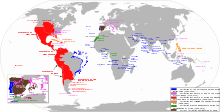The California mission clash of cultures occurred at the Spanish Missions in California during the Spanish Las Californias-New Spain and Mexican Alta California eras of control, with lasting consequences after American statehood. The Missions were religious outposts established by Spanish Catholic Franciscans from 1769 to 1823 for the purpose of protecting Spain's territory by settlements and converting the Californian Native Americans to a Christian religion.
The Spanish occupation of California brought some negative consequences to the Native American cultures and populations, both those the missionaries were in contact with and others that were traditional trading partners. These aspects have received more research in recent decades.
Spanish era history
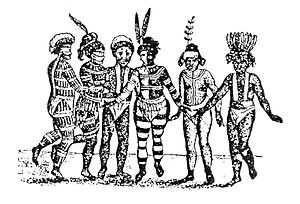
Georg von Langsdorff, early visitor to California, sketched a group of
Ohlone-Costeño dancers at
Mission San José in 1806. "
The hair of these people is very coarse, thick, and stands erect; in some it is powdered with down feathers," Langsdorff noted. "
Their bodies are fantastically painted with charcoal dust, red clay, and chalk. The foremost dancer is ornamented all over with down feathers, which gives him a monkey-like appearance; the hindermost has had the whimsical idea of painting his body to imitate the uniform of a Spanish soldier, with his boots, stockings, breeches, and upper garments."
[1]Before the padres could abandon their interim missions and begin work on more permanent structures, they had to first attract and convert a sufficiently large number of local Indians, who would comprise the major portion of their work force. The priests offered beads, clothing, blankets, even food to the "heathens" to attract them to the prospects of mission life and convince them to move into the mission compound or a nearby village. Each Indian was expected to contribute a certain number of hours' labor each week towards making adobes or roof tiles, working on construction crews, performing some type of handicraft, or farming. Women wove cloth, prepared meals, washed clothes, and were generally responsible for whatever domestic chores arose at the mission.
In 1811, the Spanish Viceroy in Mexico sent an interrogatorio (questionnaire) to all missions in Alta California regarding the customs, disposition, and condition of the Mission Indians.[2] The replies, which varied greatly in length, spirit, and even value of information, were collected and prefaced by the Father-Presidente with a short general statement or abstract. He sent the compilation to the viceregal government.[3] The contemporary nature of the responses, no matter how incomplete or biased some may be, are nonetheless of considerable value to modern ethnologists. The Indians also spent much of their days learning the Christian faith, and attended worship services several times a day (Fray Gerónimo Boscana, a Franciscan scholar who was stationed at Mission San Juan Capistrano for more than a decade beginning in 1812, compiled what is widely considered to be the most comprehensive study of prehistoric religious practices in the San Juan Capistrano valley).[4]
Mexican era history
When Spain lost control of Las Californias and all of New Spain, due to the Mexican War for Independence succeeding, it left primarily Spanish Franciscan missionaries, suspect to the new Mexican government, managing the mission building complexes in the new Alta California. Much of the prime agricultural lands had Californos with Spanish land grants who remained, who tended to utilize the Indian peoples as a form of enslaved labor. The Mexican land grant period formed many more ranchos in California from mission and Native American lands.
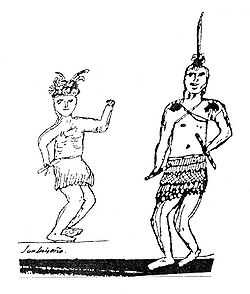
Pablo Tac, who lived at Mission San Luis Rey in the 1820s and 1830s, penned this drawing depicting two young men wearing skirts of twine and feathers with feather decorations on their heads, rattles in their hands, and (perhaps) painted decorations on their bodies.
[5] Contemporary research
In recent years, much debate has arisen as to the actual treatment of the Indians during the Mission Period, and many claim that the California Mission system is directly responsible for the decline of the Native American populations. It has been generally held that most Indians enjoyed their new lives, and that many were able to sustain themselves after the fall of the mission system by utilizing the skills they had acquired at the missions. The Indians were purportedly often granted leave to visit their villages and participated in many ceremonies and celebrations throughout the year at the urging of their benefactors. Modern anthropologists cite a cultural bias on the part of the missionaries that blinded them to the natives' plight and caused them to develop strong negative opinions of the Californian Native Americans.[6]
Evidence has now been brought to light that puts the Californian Native Americans' experiences in a very different context.[7] For instance, women were quartered separately from the men, regardless of marital status. Once an Indian agreed to become part of the mission community, he or she was forbidden to leave it without a padre's permission, and from then on led a fairly regimented life learning "civilized" ways from the Spaniards. Indians were often subjected to corporal punishment and other discipline as determined by the padres.
Population
While the native population throughout pre-contact California has sometimes been estimated to be in excess of 300,000, according to one estimate the native population in and around the missions proper was approximately 80,000 at the time of the secularization; others claim that the statewide population had dwindled to approximately 100,000 by the early 1840s, due in part to the natives' exposure to European diseases for which they lacked immunity, and from the Franciscan practice of cloistering women in the convento and controlling sexuality during the child-bearing age. (Baja California experienced a similar reduction in native population resulting from Spanish colonization efforts there).[8][9]
See also
References
- Cook, Sherburne F., Ph.D. (1976). The Population of the California Indians, 1769-1970. University of California Press, Berkeley, CA. ISBN 0-520-02923-2.
- Crump, S. (1975). California's Spanish Missions: Their Yesterdays and Todays. Trans-Anglo Books, Del Mar, CA. ISBN 0-87046-028-5.
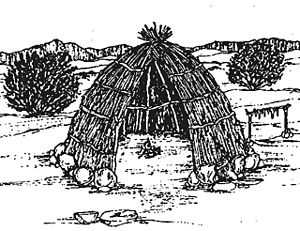
Many native cultures built cone-shaped huts (
wikiups) made of
willow branches covered with brush or mats made of tule leaves. The shelters were utilized primarily for sleeping or as refuge in cases of inclement weather. Europeans generally regarded such contrivances as "
...evidence of the Indians' inability to fashion more sophisticated structures."
[10]- Engelhardt, Zephyrin, O.F.M. (1922). San Juan Capistrano Mission. Standard Printing Co., Los Angeles, CA.
- Geiger, M., O.F.M. (1969). Franciscan Missionaries in Hispanic California, 1769-1848: A Biographical Dictionary. Huntington Library, San Marino, CA.
- Johnson, P., ed. (1964). The California Missions. Lane Book Company, Menlo Park, CA.
- Hittell, Theodore H. (1898). History of California, VOlume I. N.J. Stone & Company, San Francisco, CA.
- Kelsey, H. (1993). Mission San Juan Capistrano: A Pocket History. Interdisciplinary Research, Inc., Altadena, CA.
- Kroeber, Alfred L. (1908). "A Mission Record of the California Indians". University of California Publications in American Archaeology and Ethnology 8 (1): 1–27.
- Lippy, Charles H. (1985). Bibliography of Religion in the South. Mercer University Press, Macon, GA.
- McKanna, Clare Vernon (2002). Race and Homicide in Nineteenth-Century California. University of Nevada Press, Reno, NV. ISBN 0-87417-515-1.
- Meadows, D. (1965). "The First Europeans Contact with the Indians." Pacific Archaeological Society Quarterly 1 (3) 25-29.
- Paddison, Joshua (ed.) (1999). A World Transformed: Firsthand Accounts of California Before the Gold Rush. Heyday Books, Berkeley, CA. ISBN 1-890771-13-9.
- Rawls, James J. (1984). Indians of California: The Changing Image. University of Oklahoma Press, Norman, OK. ISBN 0-8061-2020-7.
- Ruscin, Terry (1999). Mission Memoirs. Sunbelt Publications, San Diego, CA. ISBN 0-932653-30-8.
- Wright, R. (1950). California's Missions. Hubert A. and Martha H. Lowman, Arroyo Grande, CA.
Notes

An illustration depicts the brutal death of Father Luís Jayme by the hands of angry natives at Mission San Diego de Alcalá, November 4, 1775.
[11] The uprising was the first of a dozen similar incidents that took place in Alta California during the Mission Period; however, most rebellions tended to be localized and short-lived due to the Spaniards' superior weaponry (native resistance more often took the form of non-cooperation, desertion, and raids on mission livestock).
[12][13]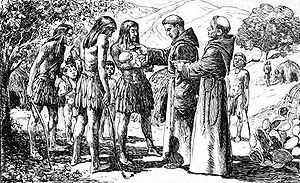
The first recorded baptisms in
Alta California were performed on July 22, 1769 in "The Canyon of the Little Christians" in what today is southern
Orange County.
[14]
- ↑ Paddison, p. 130
- ↑ Kroeber, p. 1
- ↑ Kroeber, p. 2: "Some of the missionaries evidently regarded compliance with the instructions of the questionnaire as an official requirement which was perfunctorily performed. In many cases no answers were given various questions at certain of the missions."
- ↑ Rawls, p. 26: Boscana deduced that the "Indians of California may be compared to a species of monkey" and described the native beliefs and customs as "horrible," "ludicrous," and "ridiculous."
- ↑ Kelsey, p. 4
- ↑ McKanna, p. 15; also, per Hittell, p. 753: "Boscana himself and his brother missionaries were men of narrow range of thought, continually seeking among the superstitions of the natives for resemblances of the true faith and ever ready to catch at the slightest hints and magnify them into complicated dogmas corresponding afar of those they themselves taught."
- ↑ Lippy, p. 47: "A matter of debate in reflecting on the role of Spanish missions concerns the degree to which the Spanish colonial regimes regarded the work of the priests as a legitimate religious enterprise and the degree to which it was viewed as a 'frontier institution,' part of a colonial defense program. That is, were Spanish motives based on a desire to promote conversion or on a desire to have religious missions serve as a buffer to protect the main colonial settlements and an aid in controlling the Indians?"
- ↑ Rawls, p. 6: Estimates for the pre-contact populations of most native groups in California have been based on a number of different sources, and therefore vary substantially; see Population of Native California.
- ↑ Cook, p. 200: When assessing the relative importance of the various sources of the native population decline in California, including Old World epidemic diseases, violence, nutritional changes, and cultural shock, it is clear that declines tended to be steepest in the areas directly affected by the missions and the Gold Rush. "The first (factor) was the food supply...The second factor was disease...A third factor, which strongly intensified the effect of the other two, was the social and physical disruption visited upon the Indian. He was driven from his home by the thousands, starved, beaten, raped, and murdered with impunity. He was not only given no assistance in the struggle against foreign diseases, but was prevented from adopting even the most elementary measures to secure his food, clothing, and shelter. The utter devastation caused by the white man was literally incredible, and not until the population figures are examined does the extent of the havoc become evident."
- ↑ Rawls, p. 29: In the late 1780s, French naval officer and explorer Jean-François de Galaup, comte de La Pérouse described the native dwellings in and around Monterey—consisting of long poles stuck in the ground and drawn together to form arches, then covered with thatch—as "...the most miserable that are to be met with among any people."
- ↑ Ruscin, p. 12
- ↑ Paddison, p. 48
- ↑ Engelhardt 1922, p. 12: Not all of the native cultures responded with hostility to the Spaniards' presence; Engelhardt portrayed the natives at Mission San Juan Capistrano (dubbed the "Juaneño" by the missionaries), where there was never any instance of unrest, as being "uncommonly friendly and docile." Father Juan Crespí, who accompanied 1769 expedition, described the first encounter with the area's inhabitants: "They came unarmed and with a gentleness which has no name they brought their poor seeds to us as gifts...The locality itself and the docility of the Indians invited the establishment of a Mission for them."
- ↑ Engelhardt, p. 258
External links
Populations of Native California groups |
|---|
| |
|
|
|---|
|
Asistencias
Estancias
See also
|
|





